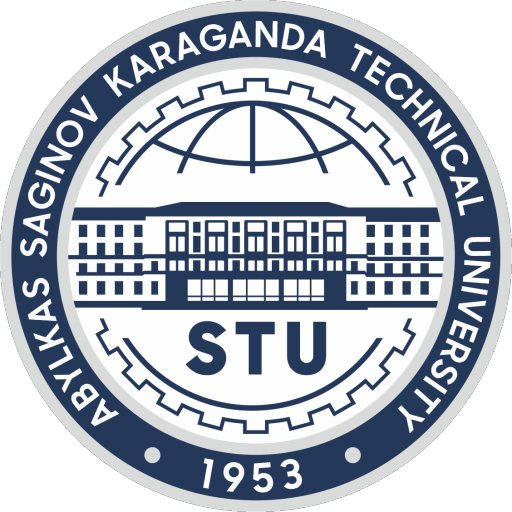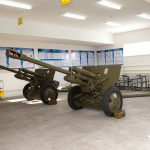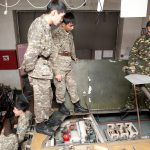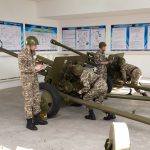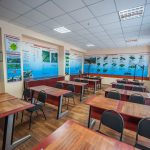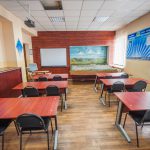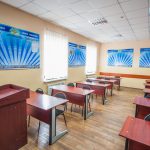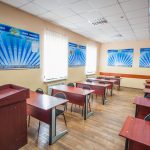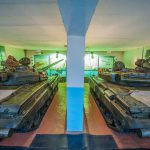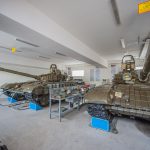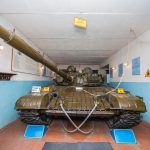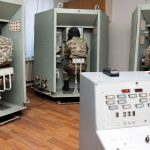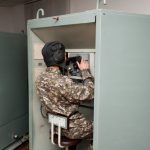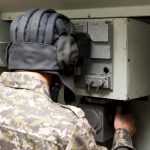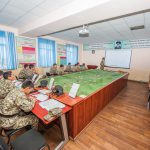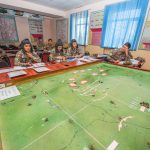Military department
he department has all the documentation regulating educational and methodological activities. All the documents of the department are conducted in accordance with the requirements of ISO 9001:2000. In order to improve the quality of teaching open and ostentatious classes are conducted, the results of mutual visits are made out in the journal. To improve the methodological training of teachers in the department operates a methodical cabinet. The cabinet is equipped with posters for methodical work, a computer connected to a local network, a TV and a VCR for displaying educational video films, as well as various methods of teaching disciplines by experienced teachers of the department. In the cabinet there are 127 units of educational military literature, which is of great interest, both for teachers and for trainees. Council of a methodical cabinet under the chairmanship of the head of the training section of Colonel Ponkratova S.P. extensive creative work is carried out to collect, summarize and analyze information related to significant historic personalities, events or dates. Since March 2004, with the support of the University’s rectorate, the initiative-creative group of the PPS of the department is actively engaged in the creation of educational video films. The catalog of video films for today consists of 48 films, 18 of which are created directly on the chair, 8 of them in the state language. On an independent preparation, twice a month, students watch educational videos, depending on the subject of the passage of the disciplines of military training. The department has its own video studio, the equipment of which produces video material and video editing. At the department on the eve of conducting the training sessions with the students of the department, instructors and methodical classes (IMZ) are conducted, which bring together a uniform teaching methodology for the classes. At the department, 31 IMZs were conducted. At the department’s meetings one of the agenda items discusses open classes held in the previous month.
The state of the educational material and technical base
The department is located in an isolated two-story building. The repair was carried out in 2011. In 2013, it is planned to finish the boxes for military equipment. The adjacent territory is equipped, periodically cleaned, laid paving slabs, there are green spaces, in the summer flowers are planted. During the training period, the training and field facilities of the training center are used. Spassk. During the current training sessions, field classes are held next to the military department.
The site of artillery pieces for the training of platoon and army artillery platoons
Brief description: on the artillery pad are three 152 mm. guns howitzer D-20, three 76 mm cannon ZIS-3, 10 posters, revealing the whole essence of the combat work of artillery units.
Opportunities: provides training on tactical and special training: on all topics of combat work and on topics of tactical training studying the effect of artillery units.
The panorama of the terrain makes it possible to carry out the alignment of guns, to conduct direct fire fire, to perform topo-geodesic binding, to make direct guarding and self-defense of fire platoons in a firing position, to compile a scheme for anti-tank fire, to determine the smallest sights, and to construct a parallel fan.
The class of combat use of artillery for the training of platoon and army artillery platoons
Brief description: the class is intended for conducting group sessions and exercises, practical classes and independent work with students on tactical and special training.
Opportunities: provides training using information technology. In the flash miniature polygon, tasks are performed to defeat the fixed target target with fire from a closed fire position.
Computer class artillery cycle for the training of commanders platoons hull and army artillery
Brief description: in the artillery computer class there are 18 modern computers connected to the local network, an electrified tactical stand controlled by a computer, 18 equipped study places of the calculator.
Opportunities: self-training using electronic textbooks, educational films, electronic programs and presentations, electronic simulator programs developed at the military department.
On the stands are exhibited for practical work: gun panorama, artillery ballistic station, device for measuring the length of the charging chamber, nomogram of the instrumental path, bussol, rangefinders, optical sight, beam, fire control device, compass, curvimeter, correction device, etc.
Lecture Hall for the training of platoons and army artillery platoons
Brief description: in the classroom there are all modern information means for holding lecture classes for 156 seats, posters for classes on educational, social and legal work.
Opportunities: conducting a lecture using any type of information carrier The class is equipped with a projection television, a computer, a movable marker board, a digital projector with a screen, a document camera
Boxing Fire Training
Designed for conducting tank fire training and training students in fire training
Class of tank gunner training simulators
This class is equipped with six TPNT-4 simulators and is designed for training and training tank gunners with the aim of inculcating, improving and maintaining their skills of conducting “fire” from tank armament without spending ammunition and tank motor resources in conditions as close to real as possible, with imitation of the target situation on miniatures – a testing range.
Class of tactical preparation
It is intended for conducting lecture and seminar classes on tactical training, practical training for unit management in combat, group exercises for organizing combat, self-training and training in the management of subordinates on the battlefield with the use of communications, training in controlling the fire of a platoon and company in combat. Classroom equipment allows students to be trained in the organization of all types of modern combat. Using computer software, a camera document and a digital projector, you can visually flash the card of the session leader with the initial tactical situation, making it easier for the trainees to make expedient decisions, to generalize the information about the enemy obtained in various ways. Conducting trainings using a mock-up of the terrain with communication facilities facilitates the rapid acquisition by trainees of skills in the management of the unit and fire in combat.
Impact defeat simulator (CPI-1)
Designed for training students and retraining reserve officers in the specialty “Platoon Commander of Medium Tanks.”
Technical description: CPI-1 was developed at the military department of KSTU under the leadership of Colonel Alaev AA. (the authors’ group). It allows to teach and train gunners in actions in armament, in the detection and destruction of targets, and also simulates their defeat when the tank is in enclosed premises (boxes, classes) without the expense of motor resources, ammunition, fuel and lubricants. Training is possible with both switched on and off stabilizer and range finder, as well as in manual range mode, and when firing indirectly using an azimuth pointer (tower goniometer) and lateral level. Power supply circuit CPI-1 is carried out from the onboard electrical network of the tank voltage 27V. You can use a step-down transformer with a rectifier block that converts the voltage of household electrical networks into a constant voltage of 27V. In the range input mode without switching on the stabilizer, it is possible to use a battery with a voltage of 24-27 V, connecting them to an external start socket. One battery is enough for 3 – 4 hours of continuous operation. CPI-1 consists of a light gun, an electrical circuit and a screen with targets.
The light gun is a homemade lantern with a 27V incandescent bulb and calibrated nozzles and is designed to deliver a light flux to the photodiodes of the electrical circuit. Calibrated nozzles are used to teach gunners more accurate aiming by adjusting the light spot. The light gun is attached to the end of the barrel of the tank gun and is connected to the terminals of the electric bullets of the gun and machine gun. As the “+” contact opens on the gun’s electric trigger and the “-” contact is opened on the electrospunce of the machine gun, it is necessary to install an electromagnetic relay (see schematic diagram) or to install two light guns (one for the cannon and the other for a machine gun).
The screen is located directly in front of the tank. On it fixed proportional targets are fixed, a panorama of the terrain is plotted and elements of the electrical circuit are placed. The panorama of the terrain must correspond to the terrain of the likely theater of military operations. In case of insufficient illumination of the room, the screen should be illuminated with additional electric illuminators or use the OU-3GK illuminator (the “Angle” headlamp) without a filter so that the gunner can clearly see the scale of the sight.
Development of tasks: before the beginning of the lesson, the leader at the training site must compose fire tasks for training the trainees. In the technical description of the sight of the TPD-K1 it is indicated that when measuring the distance to the target less than 500 m, the range-range sight scale is set to D = 700-900 m, depending on the correction setting for the ballistic guide. Therefore, when training with a rangefinder on fire tasks, the range to targets should be 700-900 m. When compiling tasks for training in the manual range mode, the range to the target is determined by the position of the photodiode on the screen and the placement of the light gun on the trunk of the standard gun.
Simulator of defeat of air targets (IPVC)
Designed for training students and retraining reserve officers in the specialty “Platoon Commander of Medium Tanks.”
The simulator of the defeat of air targets (IPVC) was developed in 1998 at the military department of KSTU under the leadership of Colonel Alaev AA. (the team of authors) for training the correct aiming on air targets from ZPU-72. It allows to train and train actions with ZPU-72 using the K-10T kolymator sight without the expense of motor resources, ammunition, fuel, lubricants. Installation IPVTS possible directly in the pits, on the tank fire camps, in classes of fire training. The power supply of the electrical circuit of the IPVC is carried out from the electric network of alternating current with a voltage of 220V. IPVC consists of a radiation unit, an electric control circuit for the target and a screen with a panorama of the terrain and the target.
The radiation unit is designed to deliver a light pulse to the electrical control circuit of the target. It is attached to the cradle ZPU-72, preliminarily balanced by additional weights. This unit operates in two modes: – with short-time radiation; – with constant radiation. The regime of constant radiation is used, as a rule, at the initial stage of training to inculcate the initial skills in using controls of the anti-aircraft machine gun. In the process of improving the trainee’s skills, it is recommended to use a mode with short-term radiation, which corresponds to 10-15 rounds. Manual adjustment of the rate of fire is carried out by potentiometer R3. The entire electrical circuit of the radiation unit is powered by the on-board network of the tank or from a 24-27V DC source.
The screen is designed to place the target and the elements of the electric control circuit of the target. It shows a panorama of the area. The target in the form of an airplane is fixed to a thread, which is connected to the motor shaft via free rollers. By changing the circumferential rollers of the target, it is possible to impart different directions of motion. The terrain panorama according to the terrain must correspond to the terrain of the likely theater of military operations.
Work order: the trainee takes the place of the commander of the tank. The leader issues a command to open fire from the ZPU-72. The trainee moves the installation from the marching position to the combat position and guides it to the target through the collimator sight. When you press the shutter release button of the NSVT machinegun, the contacts of the SB1 switch are closed, and the light flux is emitted. If the learner correctly made an aiming and aiming the weapon at the target, the light flux hits the phototransistor UT5, causing the photo relay to operate on transistors UT1, UT2. At the same time, the LEDs UD11-UD13, simulating the bullet traces, light up on the screen and the power supply circuit of the target electric motor is switched on. The target begins to move. Due to the slits made in the target, the trainee sees how the bullet routes pass through it. Passing through the entire field of view of the K-10T sight, the target, with the help of its permanent magnets and reed switches SF1 and SF2, carries out a voltage reversal in the supply circuit of the electric motor M1, returning the target to its original position. If the trainee incorrectly assigned the initial settings for shooting, the light flux does not go to the phototransistor UT5, the photo relay does not work, and the target remains in its original position.
Class of technical training for the training of deputy commanders of a motorized rifle (tank) company for armament and assistants to the heads of the armored service of the brigade for electro-special equipment and assistants to the heads of the armored service of the brigade for electro-special equipment
Brief description: in the class is the tank T-72 – 1 unit; cutting units and units of power plant and power transmission; TVs with DVD players -5 pcs.; Posters on the material part of the T-72 – 12 pcs.; tools and accessories.
Opportunities: provides training on all topics of technical training, as well as the implementation of regulations and practical work on maintenance and current repair of the tank with the use of TVs, DVDs and a set of specially designed training films. Training places equipped with televisions and DVD players prepared for performance standards and practical work on technical training
Box for the study of the material part of BMP-2, the implementation of practical work and standards for the training of deputy commanders of a motorized rifle (tank) company for armament and assistants to the heads of the armored brigade service for electro-special equipment
Brief description: BMP – 2 class for group sessions and exercises, practical classes and independent work of students on technical training; a class on the study and order of use of spare parts for the BMP-2 spare parts; class to check the technical condition of the battery.
Opportunities: provides training on all topics of technical training, as well as the implementation of standards and practical work on maintenance and current repair of BMP-2 with the use of TVs, DVDs and a set of specially designed training films
Class of technical training of deputy commanders of a motorized rifle (tank) company for armament and assistants to the heads of the armored service of the brigade for electro-special equipment
Brief description: in the classroom there is a computer – 1 pc; posters for the operation of BTWT – 14 pcs .; Electrified model of permanent park -1 pcs. a model of the field park – 1 pc.; screen – 1 pc.
Opportunities: provides classes on all topics of technical training, study of standards and practical work on maintenance and current repair of the tank with a video player, as well as studying elements of the permanent and field fleet of the brigade using an electrified layout.
